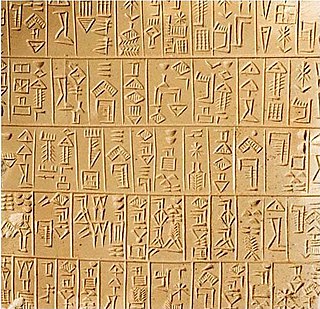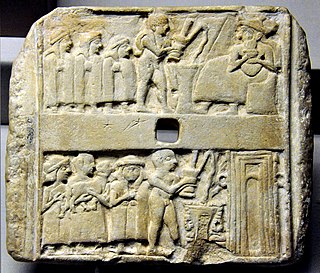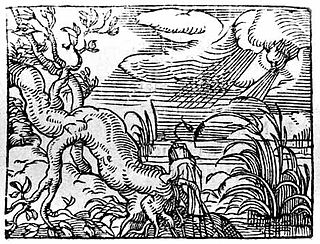Related Research Articles
Akkadian literature is the ancient literature written in the East Semitic Akkadian language in Mesopotamia during the period spanning the Middle Bronze Age to the Iron Age.

Disputation is a genre of literature involving two contenders who seek to establish a resolution to a problem or establish the superiority of something. An example of the latter is in Sumerian disputation poems.

Lugalbanda was a deified Sumerian king of Uruk who, according to various sources of Mesopotamian literature, was the father of Gilgamesh. Early sources mention his consort Ninsun and his heroic deeds in an expedition to Aratta by King Enmerkar.
Enkimdu (𒀭𒂗𒆠𒅎𒁺) was a Mesopotamian god associated with agriculture and irrigation. He is best known from the poem Dumuzi and Enkimdu, but in laments he was instead connected with the god Martu, who like Dumuzi could be described and depicted as a shepherd.

Sumerian literature constitutes the earliest known corpus of recorded literature, including the religious writings and other traditional stories maintained by the Sumerian civilization and largely preserved by the later Akkadian and Babylonian empires. These records were written in the Sumerian language in the 3rd and 2nd millennia BC during the Middle Bronze Age.

Dumuzid, titled the Fisherman, was a legendary Sumerian king of Uruk listed originating from Kuara. According to legend, in the one-hundredth year of his reign, he was captured by Enmebaragesi.

The "Debate between bird and fish" is an essay written in the Sumerian language on clay tablets, dating back to the mid to late 3rd millennium BC. It belongs to the genre of Sumerian disputation.

Sumerian religion was the religion practiced by the people of Sumer, the first literate civilization found in recorded history and based in ancient Mesopotamia, and what is modern day Iraq. The Sumerians widely regarded their divinities as responsible for all matters pertaining to the natural and social orders of their society.

The Oak and the Reed is one of Aesop's Fables and is numbered 70 in the Perry Index. It appears in many versions: in some it is with many reeds that the oak converses and in a late rewritten version it disputes with a willow.

The "Debate between sheep and grain" or "Myth of cattle and grain" is a Sumerian disputation and creation myth, written on clay tablets in the mid to late 3rd millennium BC.

The Debate between Winter and Summer or Myth of Emesh and Enten is a Sumerian creation myth belonging to the genre of Sumerian disputations, written on clay tablets in the mid to late 3rd millennium BC.

The Sumerian disputation poem or Sumerian debate is a genre of Sumerian literature in the form of a disputation. Extant compositions from this genre date to the middle-to-late 3rd millennium BC. There are six primary poems belonging to this genre. The genre of Sumerian disputations also differs from Aesopic disputations as the former contain only dialogue without narration. In their own language, the texts are described as adamin in the doxologies at the end of the poem, which literally means "contests (between) two".
The "Series of the Poplar" is an Akkadian disputation poem containing a discussion between a Poplar, an Ash, and probably other trees, who each tries to establish his preeminence in the vegetal kingdom by listing their many uses and excellent qualities. Most of the surviving examples of the work are from the library of King Assurbanipal of Nineveh, "one of the most important repositories of texts from the entire ancient world".
The Series of Ox and Horse is an Akkadian disputation poem. It contains a poetic dispute between an ox and a horse and perhaps other animals. Around 200 mostly fragmentary verses are known, but it is uncertain how long the text originally was, or in which order the preserved fragments should be arranged.
Palm and Vine is an Akkadian disputation poem. It contains a disputation poem between two litigants, Palm and Vine, each of which praises its own merits and many uses, and discredits those of its rival. The text may have been composed in the second-millennium BCE, but only first-millennium manuscripts of it are known. Fifty-four lines from the middle section of the text are preserved, which begin in medias res with a long speech of Palm, immediately followed by Vine's rejoinder. Three library manuscripts of the poem are known, as well as an excerpt on a peculiar school tablet.
The Story of the Poor, Forlorn Wren is a work of Akkadian literature in the form of a disputation, preserved only in late manuscripts. It contains a fable featuring a wren and an eagle. It is an example of poetic expression in the literature of Iraq in the first millennium BCE.
The Debate between tree and reed is a work of Sumerian literature belonging to the genre of disputations poem. It was written on clay tablets and dates to the Third Dynasty of Ur. The text was reconstructed by M. Civil in the 1960s from 24 manuscripts but it is currently the least studied of the disputation poems and a full translation has not yet been published. Some other Sumerian disputations include the dispute between bird and fish, cattle and grain, and Summer and Winter.
The Debate between the hoe and the plough is a work of Sumerian literature and one of the six extant works belonging to this literature's genre of disputations poem. It was written on clay tablets and dates to the Third Dynasty of Ur and runs 196 lines in length. The text was reconstructed by M. Civil in the 1960s. The two protagonists, as in other disputation poems, are two inarticulate things: in this case, two pieces of agricultural equipment, the hoe and the plough. The debate is about which is the better tool.
The Debate between silver and copper is a work of Sumerian literature and one of the six extant works belonging to this literature's genre of disputations poem. It was written on clay tablets and dates to the Third Dynasty of Ur and runs 196 lines in length. The text was reconstructed by M. Civil in the 1960s. Like other Sumerian disputation poems, it features two typically inarticulate things debating over which one is superior.
Tamarisk and Palm is an Akkadian disputation poem written on clay tablets and dates to the 18th century BC from the reign of Hammurabi. The poem features an argument between a tamarisk and a date palm; the Tamarisk leads in the name of the poem because it presents the first speech during the debate, followed by a reply from Palm. The text is fragmentary but appears to have followed the typical structure of Sumerian disputation poems. It was the most famous Akkadian disputation poem of antiquity, with its manuscripts ranging from the 18th to 12th centuries BC, and it continues to be the best-known Akkadian disputation today.
References
Citations
- 1 2 Jimenez 2017, p. 72.
- ↑ Jimenez 2017, p. 24–26.
- ↑ Jimenez 2017, p. 25.
- ↑ Otero 2020, p. 152.
- ↑ Jimenez 2017, p. 4.
- ↑ Lambert 1996.
- ↑ Jimenez 2017, p. XI.
- ↑ Jimenez 2017, p. 69.
- ↑ Jimenez 2017, p. 70–71.
- ↑ Jimenez 2017, p. 71–72.
Sources
- Jimenez, Enrique (2017). "The Babylonian Disputation Poems: With Editions of the Series of the Poplar, Palm and Vine, the Series of the Spider, and the Story of the Poor, Forlorn Wren". The Babylonian Disputation Poems. Brill. ISBN 978-90-04-33626-1.
- Lambert, Wilfred (1996). Babylonian Wisdom Literature. Eisenbrauns. ISBN 978-0-931464-94-2.
- Mittermayer, Catherine (2020). "The Sumerian Precedence Debates: The World's Oldest Rhetorical Exercises?". In Jimenez, Enrique; Mittermayer, Catherine (eds.). Disputation Literature in the Near East and Beyond. De Gruyter. pp. 11–32. ISBN 978-1-5015-1021-2.
- Otero, Andrés Piquer (2020). "Those Who Cannot Do, Reign? The Sources of the Fable of Jotham". In Jimenez, Enrique; Mittermayer, Catherine (eds.). Disputation Literature in the Near East and Beyond. De Gruyter. pp. 143–156. ISBN 978-1-5015-1021-2.